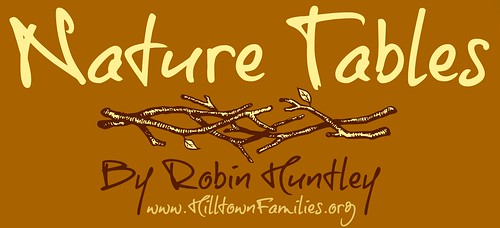Nature Table for August: Autobiography
Nature Table for August

Every month, Hilltown Families features a new nature table whose contents inspire learning along a common theme easily spotted in our surroundings that month. A tradition carried out by teachers, environmental educators, and nature-curious families, nature tables bring a little bit of the outdoors inside for inspection, dissection, identification, creative play, art projects, and lots of other educational activities. The idea behind a nature table is to help open up children’s eyes to the unique attributes of each season, and to help them learn how to see these things in nature for themselves. A nature table can include a variety of items, and is often accompanied by a set of books and/or field guides so that children can take part in further learning at their own will.
August is heavy in the air. Slightly shortened days, daytime humidity, and a slight evening chill are the hallmark (and ominous) signs of a summer that has begun to give way to fall. As always, we’re attuned to the changes happening in the natural world around us, yet somehow our emotional response to the change in seasons can cloud our ability to notice the natural phenomena nearby. Rather than marveling in the shifts taking place all around us (dandelions are scarce, baby birds have fledged, berries are almost out of season), August tends to make us nostalgic – the impending ending inspiring reflection rather than observation.
As a compulsive treasure collector, I gather small souvenirs wherever I go. My house, my car, my backpack, my pockets, and the house, car, backpack, and pockets of everyone I adventure with are littered with tiny specimens. Sometimes delicate and always fascinating, these treasures hold stories. Not only are they emblematic of a certain type of habitat, a growing season, or the cycle of life and death, they serve as narration for my summer adventures. The small pile that has accumulated is a double autobiography: it shares the story of the landscape, and shares my story as well. The way that I have moved through the landscape and the ways that I have interacted with my surroundings all become clear in this mini-museum of summer’s artifacts.

When the summer began, we spent hours in our garden. We’ve mostly succeeded, but my collection of feathers tells a story of garden struggle. The seeds we had sown were delicious to our local rafter of turkeys, as well as the two rogue roosters who inhabited some nearby brambles for a month or so. The turkeys lost their feathers naturally, I assume, while the roosters both disappeared into a mammal’s mouth, leaving feathers littered across the lawn. Other avian treasures – namely, nests and egg shells – tell a much more uplifting story of the magic I witnessed daily as baby sparrows hatched, grew, and fledged with great success.
A tiny tin of crab legs, barnacle bits, and urchins is disguised as Altoid mints – so well disguised, in fact, that I convinced even myself that’s what was inside and allowed the treasures to float around in my backpack longer than I should have. They’re a little worse for the wear, but their incredibly delicate details remain largely intact. Nearly camouflaging with the sand, these treasures were discovered through close observation of a sandy patch blanketed in seaweed. The work of finding these minute specimens was almost meditative, requiring slow, deliberate searching and sifting.
Bunches of lichen bring my story away from the beach and into the woods. I’ve hiked all over New England since summer began, and these crisp blue-and-green bunches of lichen speak to the trails I’ve traversed. Foliose, fruticose, and crustose species decorate the floor of evergreen forests more often than deciduous ones, I’ve noticed. When it rains, they come alive with color; when it’s dry, they shrink back into their surroundings, those who grow on bark blending in better than ever.
Other treasures tell other stories, seemingly endless. Razor clams, bits of dishes, snail shells, and even a tiny plastic figurine all hold their own tale of the landscape and my interaction with it.
As summer comes to a close, I’ll use the summer’s nature table as inspiration for reflection. How did I interact with my surroundings? What did I notice? What did I learn? Where did I go? What do these treasures say about my place in the world?
Go find some treasures. Let them tell your story.
Robin Morgan Huntley, Community-Based Education Correspondent
 A native to Maine, Robin joined Hilltown Families in early 2011 as an intern and remained over the years volunteering as a community-based education correspondent until moving back to Maine in 2016. Robin is a graduate of Antioch University with a masters in education. Her interests within the field of education include policy and all types of nontraditional education. For her undergraduate project at Hampshire College, Robin researched the importance of connecting public schools with their surrounding communities, especially in rural areas. Robin currently lives with her husband, cats and rabbits in Maine and is a 5th grade public school teacher.
A native to Maine, Robin joined Hilltown Families in early 2011 as an intern and remained over the years volunteering as a community-based education correspondent until moving back to Maine in 2016. Robin is a graduate of Antioch University with a masters in education. Her interests within the field of education include policy and all types of nontraditional education. For her undergraduate project at Hampshire College, Robin researched the importance of connecting public schools with their surrounding communities, especially in rural areas. Robin currently lives with her husband, cats and rabbits in Maine and is a 5th grade public school teacher.
 Hilltown Families
Hilltown Families 




























